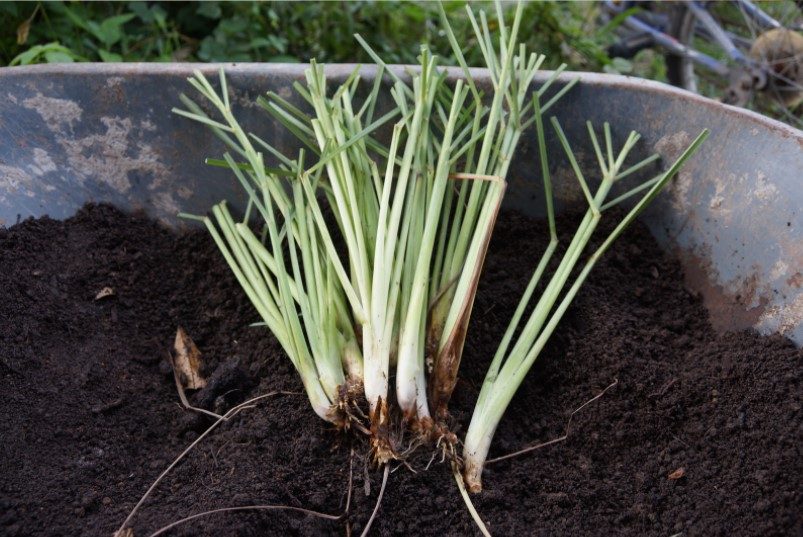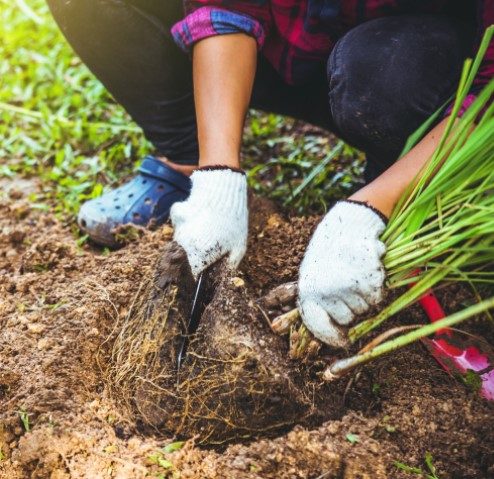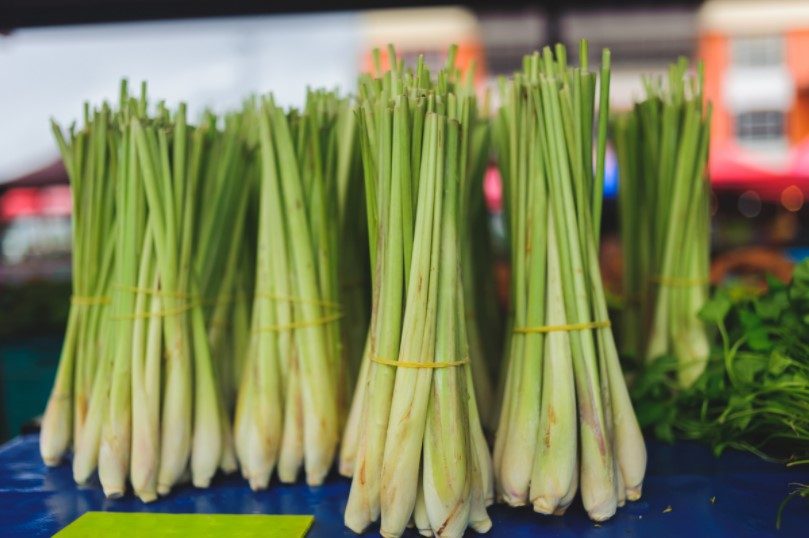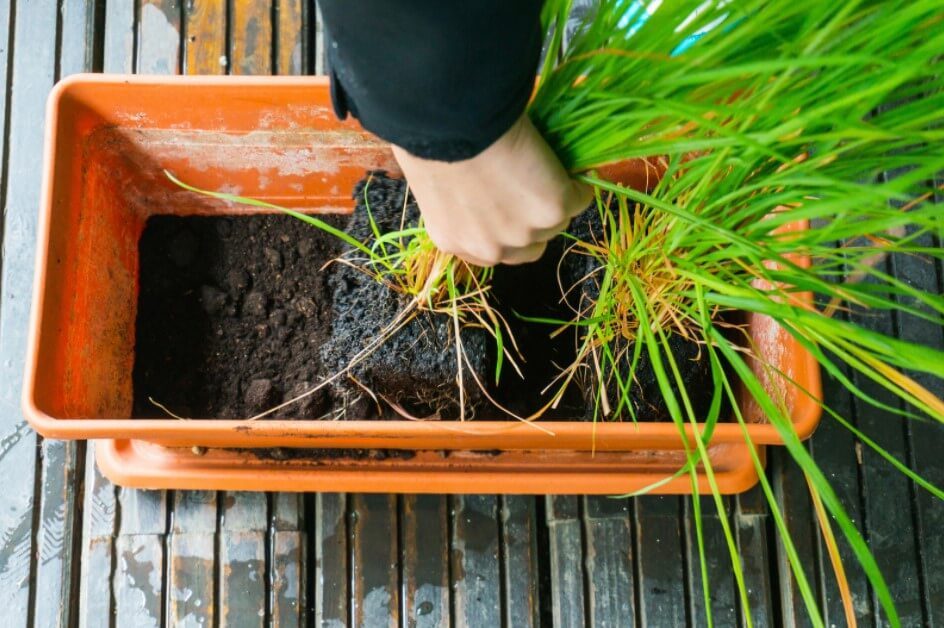As its oil and leaves are commonly used to create medicine, lemongrass is also one of the most refreshing additions to food and beverages due to its rich flavor and aroma.
If you’re a huge fan of herbal teas (just like me), then you don’t need any explanation about this amazing plant. Its strong citrus flavor also makes it a commonly found ingredient in much Asian cooking.
Moreover, the plant presents tons of benefits for our body, such as improving cholesterol and sugar levels, reducing fever, and relieving swelling or pain.
Now the question remains: how to grow lemongrass at home successfully?
Let’s dive straight into the important point because lemongrass can be a little bit tricky to navigate if you’re a first-timer in planting it at home.
However, don’t worry too much! I’ll try my best to simplify the information you need so that you don’t end up getting confused by the end of your reading.
In this post
Varieties

Like any other plants or herbs, lemongrass comes in several varieties that you can choose according to your needs, environmental conditions, etc. However, these are the two most popular varieties:
- West Indian lemongrass (Cymbopogon citratus), a variety that’s native to maritime Southeast Asia, grows easily in any warm climate and most used for cooking, and
- East Indian lemongrass (Cymbopogon flexuosus), a variety that’s native to Thailand, Burma, Sri Lanka, India, Laos, Vietnam, and Cambodia, and has purple tinges in its stems.
When to Plant Lemongrass
To know how to grow lemongrass is to know the best time to plant the herb first.
The answer is spring!
When all that snow and frost have melted away, you’ll need soil you can work with. If you don’t have a yard or garden, lemongrass can also be planted in containers.
Besides the temperature of springtime, your soil should also be well-drained with an acidic pH (6.5 to 7.0).
If your soil is also drought-tolerant, you probably don’t even need much water.
Where to Plant Lemongrass

As previously mentioned, lemongrass strives in a warm to hot climate. Therefore, an area with full sun exposure should be more than enough!
Moreover, considering that lemongrass plants thrive in all conditions, you don’t have to worry about this part. However, it’s still highly advised to make sure your lemongrass gets enough sun.
Besides the option of planting in containers, lemongrass also looks great in garden beds. However, don’t forget to make sure that you have a wide space to accommodate their growth.
Lemongrass typically can grow up to 32 inches (80 cm) wide and 47 inches (1.2-meters) tall. It’ll be quite big if you have a small space!
You can also enrich your soil by combining several inches of aged compost or other rich organic matter.
How to Plant Lemongrass

You can start your planting journey from containers, both indoors and outdoors. There are three options of how to grow lemongrass:
1. From Seeds
Go with the most basic option: lemongrass seeds, and prepare them for germination, which will usually take around three weeks. Space the seeds 2 inches (5 cm) deep and 20 inches (50 cm) apart.
2. From Stem Cuttings
You can also opt for propagating your lemongrass from cutting the stem. To do this, go to your local fresh food and select the freshest stalk you can find.
Once you’re back home, peel back any dead leaves before setting them inside a glass of water on a sunny windowsill.
In about three weeks, roots will begin to grow, which you can transfer to the soil.
3. From Stalk
Another unique option is purchasing a lemongrass bush, and use the stalk to grow a new plant. Here’s how to do it:
- Remove the brown leaves from the stalk
- Put the stalk into the water and make sure it gets enough sun light
- Wait for several days until it grows roots while keeping the water’s volume by changing or adding the water every other day
- Once the roots grow long (~3 inches), you can plant it directly on the rich-nutrient soil
How to Take Care of Lemongrass
The most challenging (and exciting!) part in gardening is actually the part where we take care of them. You can follow all the best procedures in growing your favorite plants, but the jury’s still out on how you care for them.
Pay attention to the surface layer of the soil. Lemongrass requires consistent moisture and water to avoid dryness. So if you’re in zone 9a, you’ll need a container to grow lemongrass. But if you live in zone 8, it’s okay to plant lemongrass on the ground.
You’ll also need to feed the plant regularly with a portion of water-soluble plant food.
Here’s more you need to know about how to grow lemongrass successfully for a long time.
1. Fertilizing
Your current soil can be further idealized by adding several different soil amendments: leaf mold, manure, and compost—all of which belong to enriching additives for plants.
Considering its grassy nature, lemongrass can benefit from a nitrogen-rich fertilizer such as the 6-4-0 fertilizer that’ll feed and support them throughout the growing season.
Another option includes watering your plant with manure fertilizer tea, which is rich in nutrients and always regarded as an ideal fertilizer for garden plants.
2. Harvesting
Both lemongrass’ foliage and stalk can be harvested according to your needs. The principle here is to wait until they’re at least 12 inches (31 cm) tall.
For harvesting the stalk, you can break it off with your finger or cut it with a pair of scissors. The part that’s the closest to the ground is usually the most tender.
Moreover, always aim to harvest lemongrass before the first frost sets in. Discard any discolored or unhealthy lemongrass.
3. Storage
Clean the stalk from sands and dirt and remove the leaves. Fresh lemongrass is ready to be cooked, or you can freeze them for later use.
When frozen in the refrigerator, lemongrass stalks can last for around 6 months.
There’s also another option to dry lemongrass leaves and stalks as well. Begin by cutting the fresh lemongrass into smaller pieces, and then lay them all on paper towels. Make sure to dry them in a dry area that’s out of direct sun exposure. Once they’re properly dried out, move them into a separate jar that’s sheltered in a cool, dark place. You can use dried lemongrass for up to a year.
Lemongrass’ Plant Companions
Here are several plants you can consider planting alongside your lemongrass:
Thyme and Rosemary
The aromatic herbs of thyme and rosemary turn out to be very benefiting for lemongrass, considering how they both prosper when planted in dry soil and under direct sunlight.
They’ll also thrive in wetter, shadier spots when planted alongside your lemongrass, hence adding more flexibility to your planting session.
Cilantro
Also known as coriander, cilantro is a classic ingredient in our kitchen thanks to its rich flavor and scent. Planting cilantro near your lemongrass can help attract hoverflies and other beneficial pollinators to the garden.
Ginger
Next, we have a spicy spice commonly utilized for its medicinal properties.
Although not everybody is a fan of its strong flavor, ginger can be a great addition for your garden—especially near lemongrass, which will help to “tone down” the flavor a bit.
Thai Basil
With a close tie to the mint family, it’s a no brainer that Thai basil is most commonly found in cuisines from Thailand and its surroundings.
Some of the essential oils in Thai basil benefit the growth of lemongrass, so it won’t hurt to plant this one in your garden, too.
More possible plant companions for lemongrass:
- Banana Peppers
- Bee Balm
- Bell Peppers
- Goji Berries
- Hops
- Hot Peppers
- Lemon Balm
- Lemons
- Limes
- Marigolds
- Mint
- Oranges
- Sage
- St John’s Wort
- Sweet Peppers
- Tomatillos
- Tomatoes (Bush)
- Tomatoes (Vine)
- Turmeric
FAQ about Growing Lemongrass
Do you have some more questions about extra details on how to grow lemongrass?
How do I trim lemongrass?
Lemongrass responds surprisingly well to being trimmed, so you really don’t have to worry about this part. Feel free to cut them up to the desired height, and leave them be for them to keep growing tall and looking good.
My lemongrass is dying after transplanting. What should I do?
Oh no, I’m so sorry to hear that! I strongly suggest you look back again at the drainage system of your container or garden. Make sure the soil isn’t overly wet or doesn’t contain too many air pockets, since it can hinder the roots from absorbing nutrients it needs.
Conclusion
We hope the information on how to grow lemongrass and other related information above can help you grow this amazing plant at home!
Besides providing amazing flavor to our cooking, lemongrass has a series of benefits for the human body and antibacterial properties.
It’s also no wonder you’ll find lemongrass in products like insect repellants, disinfectants, candles, soaps, etc. What kind of recipe featuring lemongrass do you have in mind?

